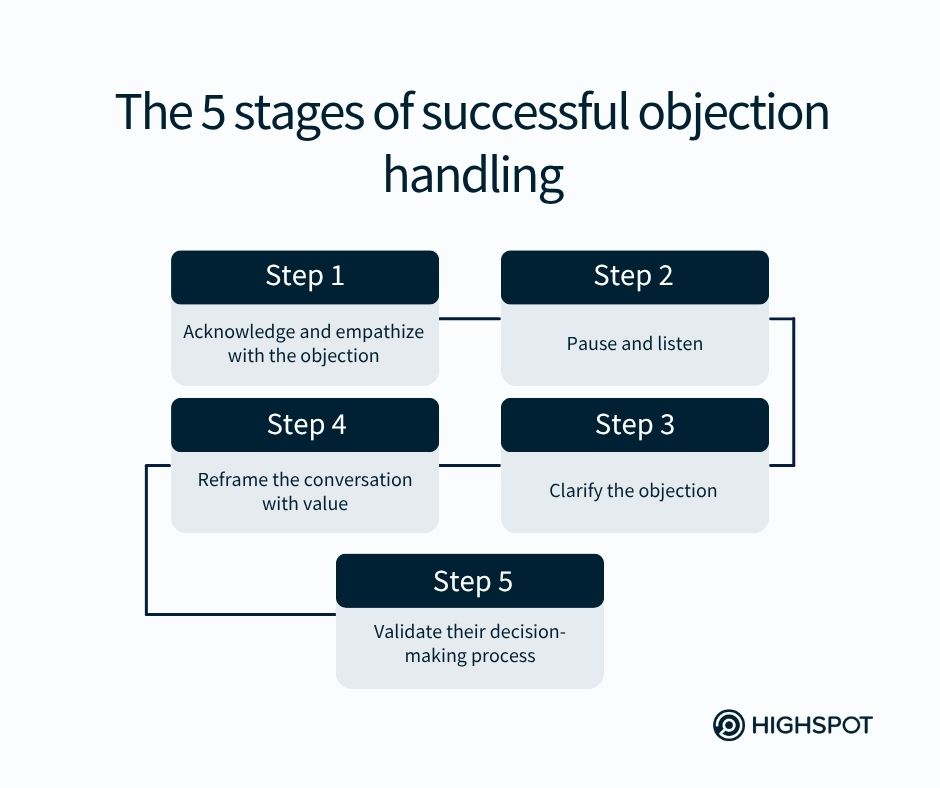Key Takeaways
- Objection handling refers to addressing a B2B buyer’s concerns during a sales conversation. It helps reps uncover what’s blocking the deal from advancing forward and guide prospects toward making confident purchasing decisions.
- Most sales objections come down to budget, timing, need, or authority. Knowing which type you’re facing can help you respond appropriately and keep deals on track.
- Strong objection handling isn’t about pushing harder. It’s about listening, understanding the ‘why’ behind the hesitation, and reframing the conversation around value.
Sarah, a seasoned sales rep, was close to sealing the deal. The prospect seemed interested, nodding along as she explained the value of her solution.
Then, it happened: “This is too expensive.” Her stomach dropped. She had rehearsed her sales pitch a hundred times and put so much time into pursuing this prospective buyer. This felt like a dead end.
Sound familiar? If you’ve worked in B2B sales for some time, you’ve undoubtedly heard objections like this more times than you can count.
But objections aren’t dealbreakers. They’re buying signals.
In fact, most customers say no multiple times before finally accepting a sales offer. This means giving up after the first “no” is a missed opportunity.
The key to successful outcomes is your sales messaging and deal navigation.
What is objection handling?
Objection handling is responding to and resolving a prospect’s objections during the sales process. Instead of avoiding objections in sales calls and seeing them as barriers, skilled reps use them as an opportunity to guide the customer journey, show value, and build trust.
When a prospect raises a concern, it’s tempting to immediately defend your product, list its benefits, or convince them they’re wrong. But that approach rarely works.
Instead, think of challenges from prospects as a chance to move the sale forward. It’s a natural part of the sales negotiation process. Every hesitation and “not right now” tells you more about what’s holding them back.
Once you understand your buyer’s pushbacks, you can guide them forward. This is your chance to let them elaborate so you can understand and address their concerns collaboratively rather than confrontationally.
The importance of objection handling in sales
Effective objection handling is fundamental to a successful sales effort. Rather than letting potential objections shut down the conversation, top sales teams use them to dive deeper into a prospect’s concerns.
An objection often reveals other pain points prospects hadn’t fully considered.
Here’s why it matters so much:
- It builds trust. When a rep handles objections with confidence and empathy, it signals credibility. Buyers see that you understand their concerns and care about finding the right solution.
- It clarifies needs. Each objection helps surface hidden priorities or deal blockers. Addressing them refines your understanding of what it’ll take to close the gap.
- It keeps deals moving. Instead of letting objections stall momentum, you can use them to re-engage and guide the buyer toward resolution.
By honing your active listening skills, observing body language, and encouraging ongoing dialogue, sales reps can address what’s driving the hesitation.
The different types of sales objections reps face
When a buyer pushes back, they rarely do so randomly. Understanding common objections helps you identify the underlying concern, which usually falls into one of four categories: Price, Timing, Need, or Authority.
1. Price objection
Budget concerns often reflect uncertainty around value rather than a lack of funds. Your buyer needs clarity on why this investment is worth prioritizing.
In this case, you must connect the dots between the cost and the business outcomes your solution supports. When you make the impact clear, the conversation will shift from price to return.
Here are a few ways these common sales objections tend to show up in real conversations and how skilled sellers turn them into value-focused discussions.
“It’s too expensive.”
- How to respond: “Let’s talk about the outcomes that would make this feel worthwhile.”
- Why it works: It helps the buyer see the cost in the context of the growth or efficiency it unlocks.
“We don’t have a budget allocated.”
- How to respond: “Many teams shift funds when they see the ROI. Can we map the potential impact?”
- Why it works: You reframe the purchase as an investment that returns budget, not drains it.
“Your competitor offered us a lower price.”
- How to respond: “That’s helpful context. For clarity, does their proposal include onboarding, analytics, and support? Those make a big difference in long-term success.”
- Why it works: You shift the comparison from price alone to the full value and outcomes the buyer actually cares about, helping them see why a lower sticker price might cost more later.
“Show me a discount first.”
- How to respond: “Before we discuss pricing changes, let’s ensure the package meets your must-have goals.”
- Why it works: You protect margins and maintain perceived value.
“We’re tightening spend this year.”
- How to respond: “Completely understand. That’s why many customers invest in tools that help them do more with less. Want to explore that angle?”
- Why it works: You position your product as a cost saver, not a line-item expense.
Pro tip: If budget is a real issue, offer some flexibility. Look into breaking the cost into phases or a pay-as-you-go subscription. Do you have a lower-tier option? Help them see a path forward instead of a dead end.
Looking to level-up your sales strategy? Download our GTM Performance Gap Report to learn how AI can accelerate revenue growth and streamline go-to-market operations.
2. Timing objection
A timing objection can mean your potential customer is juggling other priorities. In other words: “I’m not convinced this is urgent.”
Effective sales reps overcome this by showing how taking action today supports goals your buyer already cares about, or how waiting creates risks. Helping your customers see the cost of delay keeps the opportunity alive.
Here’s what timing objections look like and how to respond in a way that keeps the deal warm.
“This isn’t a priority right now.”
- How to respond: “Understood. Can you share what is the top priority today? There might be more overlap than it seems.”
- Why it works: You explore hidden urgency instead of accepting delay.
“We’re in the middle of another initiative.”
- How to respond: “Let’s sync your timelines. Some teams onboard gradually while their other initiative finishes, avoiding disruption.”
- Why it works: You solve for workflow and reduce perceived risk.
“We need to see how the next quarter goes.”
- How to respond: “Happy to align with that. What metrics would signal that now is the right time?”
- Why it works: You define a future trigger instead of leaving the deal in limbo.
“We’re waiting on internal changes first.”
- How to respond: “What changes are coming? If it helps, we can plan onboarding around them so your team is ready when everything settles.”
- Why it works: You turn a blocker into a planning opportunity.
“Let’s talk again in six months.”
- How to respond: “I can make that happen. Before we lock a date, what milestones are you aiming for in that timeframe?”
- Why it works: You keep momentum and uncover urgency that might accelerate the timeline.
Pro tip: You can offer to reduce risk with a pilot program. A small test run gives the prospect a low-pressure way to see the value firsthand.
3. Authority objection
Sales rarely move forward without the right stakeholders involved. Authority objections show that the decision process isn’t fully mapped.
Rather than pushing for immediate access, your sales reps must guide champions through what other decision-makers will want to know. Equipping them to advocate internally helps build consensus and keeps deals from stalling.
Here’s how to handle common authority objections without overstepping or losing momentum.
“I need to check with my boss.”
- How to respond: “Totally makes sense. What would they need to see to say yes?”
- Why it works: You help them build a strong internal business case rather than disappearing into email limbo.
“Our leadership isn’t bought in yet.”
- How to respond: “Happy to help get them there. Who else should be in the conversation so we can answer their questions directly?”
- Why it works: This expands your influence to true decision-makers.
“I’m not the right person to evaluate this.”
- How to respond: “Thanks for pointing me in the right direction. Who typically leads this type of initiative?”
- Why it works: You smoothly move toward the real champion while maintaining a friendly connection.
“Let me collect more team input first.”
- How to respond: “Sounds good. What feedback would be most valuable for your next step? I can equip you with materials to make that easier.”
- Why it works: You stay close to the process instead of waiting on the sidelines.
“We need cross-functional approval.”
- How to respond: “Let’s set up a short alignment call with the key stakeholders so they can weigh in early.”
- Why it works: Reduces internal friction and speeds group consensus.
Pro tip: It’s often best to schedule a call with the CFO or key buying stakeholders (with the prospect’s approval) to ensure information isn’t relayed secondhand. This allows you to address concerns directly and maintain momentum.
4. Need objection
Moving forward becomes unlikely if your buyer doesn’t feel a strong problem or opportunity. A need objection allows your team to revisit the discovery call and better understand what the buyer is trying to achieve.
The goal isn’t to create pressure but to highlight misalignment or missed potential. When the solution clearly advances their priorities, “fine for now” becomes harder to justify.
Below are some of the most common need objections and ways to respond that uncover urgency and connect your solution to what matters most.
“We’re already doing fine with our current setup.”
- How to respond: “That’s great to hear. What would need to happen for you to explore a more efficient or scalable approach?”
- Why it works: You open the door to uncovering inefficiencies without attacking their existing choices.
“I don’t see how this would help us.”
- How to respond: “Totally fair. Let me show you how a company like yours reduced admin time by 30%.”
- Why it works: Customer references make your solution more tangible and credible.
“Our problem isn’t that serious yet.”
- How to respond: “Makes sense. Can we walk through what this issue costs your team weekly?”
- Why it works: Attribution turns a vague inconvenience into a priority.
“This doesn’t align with our strategy right now.”
- How to respond: “You mentioned improving win rates. Here’s where this has an impact on pipeline conversion.”
- Why it works: Buyers rarely say no to value that ties directly to core objectives.
“We tried something similar and it failed.”
- How to respond: “That sounds frustrating. What didn’t work before, and what would success look like this time?”
- Why it works: Reps avoid comparisons until they understand what went wrong.
Pro tip: If they’re using a competitor, differentiate your solution. Ask them, “What’s one thing you wish your current vendor did better?” If your product fills that gap, you’ve just created a compelling reason to switch without directly attacking the competition.

The 5 stages of successful objection handling
Here are five stages for overcoming objections to keep the conversation flowing in a positive direction. As you go through each step, apply essential sales skills to help guide the prospect toward the decision, rather than feeling like you’re pushing them into a corner.
1. Acknowledge and empathize with the objection
Make the prospect feel heard before you respond. This doesn’t mean you agree with the specific objection—it simply shows you understand their perspective.
For instance, if a prospect says, “This seems too expensive,” don’t immediately justify the price. Instead, respond with something like, “I completely understand that budget is a big factor in your decision. Many of our customers had the same concern at first.”
This simple acknowledgment lowers their guard and keeps them talking. They might even offer further objections. You can also strengthen this by relating their worry to your other customers’ experiences.
For example, “I’ve worked with other companies in your industry that were very concerned about budget and long-term costs, and I’d love to share how they navigated that decision.”
Using empathy and validation builds trust and keeps the door open for more conversation.
2. Pause and listen
Sales reps often feel pressure to respond immediately, but objection handling in sales is just as much about practicing active listening as it is about speaking.
The first thing a prospect says isn’t always the real objection. If you jump in too quickly, you risk missing additional context and responding to the wrong pain point.
“Prioritize listening with empathy and pay more attention to signals that provide insight into customer interest, intentions, and context,” Laura Ramos, VP, Principal Analyst at Forrester, recently wrote.
For example, if the prospect says, “We don’t have the budget,” pause for a moment. They might follow up with, “It’s not just the upfront cost; it’s also the expense of integrations, training, and implementation that we will incur switching from our current vendor.”
Now you know their concern is about switching costs, not just price. That’s a broader challenge, and you can respond in a way that covers all the appropriate details.
If they don’t elaborate, you may prompt them with an open-ended question: “Can you tell me more about that?” This will hopefully uncover the real issue and keep the exchange from feeling transactional.
Get your free copy of our State of Sales Enablement Report 2025 to get expert insights and advice on how to seamlessly incorporate AI in your go-to-market efforts.
3. Clarify the objection
Once you’ve listened, confirm your understanding before responding. Many customer objections are surface-level expressions of more significant concerns, and if you misinterpret them, you risk giving the wrong response.
A great technique is paraphrasing: “It sounds like your main worry is how this will integrate with your existing system. Is that correct?”
This prevents misunderstandings because sometimes, what people say and mean are different. The prospect will also notice that you are paying attention to the granular details and taking the time to understand them before pushing a solution.
Once you’ve clarified the objection, ask more open-ended questions to uncover additional details.
- “What would make you feel more comfortable about implementation?”
- “If budget were a non-issue, what else would be important to you?”
By keeping the conversation open, you get to the root of the objection and position yourself as a problem-solver, not just a salesperson.
4. Reframe the conversation with value
Now that you understand your potential customer’s concerns, it’s time to shift the focus away from the objection and toward your product or service’s value proposition.
If price is the issue, reframe the conversation around return on investment with, “I completely understand budget constraints, and that’s exactly why our clients choose us. We help them save [X dollars/time] within [specific timeframe], ultimately making this an investment that pays for itself.”
If they’re hesitant about switching, focus on what they stand to gain, such as “Many companies in your industry are initially hesitant to switch, but after seeing how much time they save with automation, they realize they were losing more by staying with their old system.”
Instead of arguing against their objection, show them how moving forward benefits them and their business.
5. Validate their decision-making process
Finally, make them feel in control of the conversation and their ultimate decision. Prospects don’t like feeling pressured; when they do, they often withdraw.
Instead, acknowledge that this is a big decision and ask what would make them more confident moving forward. For example, “I understand this is a big decision for your team. What is the next step in your internal buying process?”
If they need approval from decision-makers, don’t just end with, “Let me know what they say.” Instead, offer to help them present to the team or provide supporting resources. For example, “Would it be helpful if I provided a business case or ROI analysis for your leadership team?”
By validating their process and offering assistance, you remove any roadblocks or hesitancy they might have and make it easier for them to move forward on their terms—setting the stage for success on the next sales call.
One effective way to master these steps is to leverage your sales playbooks. They provide structured guidelines that keep reps aligned and consistent. You can include scripted responses, tips for building rapport, and proven strategies for addressing objections, which help sales reps confidently approach every conversation.
Practicing objection handling with ongoing training and coaching
Learning to anticipate sales objections improves with real-world practice and feedback. The best way to gauge progress is to monitor how conversations progress during the sales process.
Newer sales reps may find most sales objections more challenging since responding requires strong product knowledge, competitive intel, and an understanding of customer demographics and needs. Experienced sellers aren’t immune either, since buyer expectations evolve and objections become more nuanced as deals grow in size and complexity.
To keep skills sharp, sellers need consistent practice and coaching. Reviewing discovery calls, participating in targeted sales role play, and working closely with managers all help reps refine their responses before they’re in high-stakes moments with buyers.
Leading AI tools can now enhance this process by giving your sales team a realistic and scalable way to improve objection handling. Notably, AI-powered sales training platforms like Highspot can help you accelerate this learning process with:
- AI-enabled simulations that mimic the most common sales objections and buying scenarios
- Data-driven feedback on reps’ tone, clarity, and effectiveness so they can adjust if/as needed
- Analytics on top-performing behaviors to show what works in deal discussions and why
- Conversation intelligence that analyzes calls, uncovers patterns, and highlights coaching opportunities
Technology can reinforce best practices and help reps improve faster, though the human element still matters.
“While AI reinforces the fundamentals, like objection handling or message delivery, managers and enablement leaders bring what AI can’t: lived examples, deal context, and the relationship-building instincts that set great sellers apart,” Highspot’s AI Role Play Guide explains.
This ensures that every interaction becomes a learning opportunity, leading to more confident reps, stronger customer relationships, and higher close rates.
Turn every objection into an opportunity for connection
While it would be ideal for prospects to be agreeable throughout the entire sales cycle, that’s rarely the case. When objections pop up, responding with helpful data and feedback is necessary.
Objections indicate that the customer carefully considers their decision and benefits from engaging with you during that process.
How well your team handles sales objections determines whether those conversations turn into closed deals. After all, B2B sales experience is a key factor in customers’ purchasing decisions.
This means that sales reps’ mastery of objection handling techniques can make or break a deal. That said, reps need the right tools and guidance to respond confidently and effectively to objections as they arise.
Highspot’s unified platform for GTM enablement delivers just that, offering in-the-moment training and AI-powered coaching that equips sales professionals with the skills they need to succeed.
Through real-time feedback, reps can refine their techniques and apply what they’ve immediately learned in conversations.




